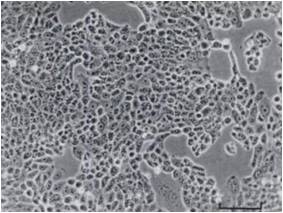A recent PNAS paper from Peter Sadler’s lab at Warwick University shows the use of Ximbio’s PEO1 and PEO4 cell lines. The cell lines were used to display the activity and potency of a new candidate drug for cancer therapy; an organometallic ‘half-sandwich’ compound [Os(ƞ6-p-cymene)(4-(2-pyridylazo)-N,N-dimethylaniline)I]PF6. Osmium offers promise as an alternative treatment for platinum-resistant cancers. A high activity, EC50 0.85-2.14, of organometallic ‘half-sandwich’ compounds containing Osmium was shown in PEO1 and PEO4 cells.

Chemical structure of the cation in [Os(ƞ6-p-cymene)(4-(2-pyridylazo)-N,N-dimethylaniline)I]PF6 (the anion PF6− is not shown). Image published in Hearn et al. 2015. Proc Natl Acad Sci U S A.
Both PEO1 and PEO4 are ovarian cancer cell lines obtained from the same patient. Both lines are an adherent cell line derived from a malignant effusion from the peritoneal ascites of a patient with a poorly differentiated serous adenocarcinoma. The patient previously received cisplatin, 5-fluorouracil and chlorambucil treatment.
The PEO cell lines, of which there are 9 in total, were derived from 4 different patients at varying stages of ovarian cancer, varying treatment plans and isolated from various malignant sites. Therefore the PEO panel provides a good model for studying the efficacy of novel drugs against ovarian adenocarcinomas.

PEO1 cells. Image published in Langdon et al. 1988. Cancer Res. 48(21):6166-72.
The PEO panel was formed by Dr Simon Langdon at The University of Edinburgh. Langdon undertook his PhD at Aston University where he was part of the research team that developed Temozolomide, a unique drug that is able to cross the blood-brain barrier and is therefore used to treat several types of brain cancer. His current research at Edinburgh focuses on identifying new targets in modified metabolic pathways in breast and ovarian cancer.
View the datasheets for more information and publications.
HAVE YOU REGISTERED?
Join the ever-growing global Ximbio community. Register and receive updates about new reagents, institutes and new features being added to the website.
